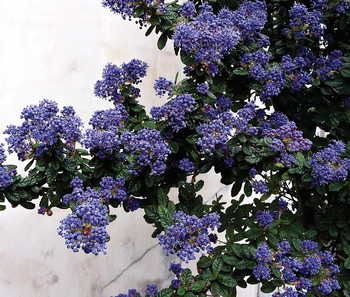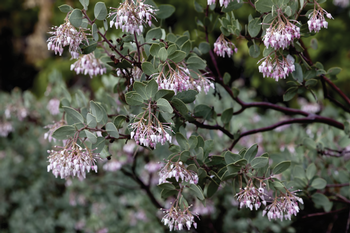The “when and why” of pruning California natives
-
Wendy Irving
-
Reoccurring drought conditions and water restrictions are leading many Marin gardeners to add California native plants to their landscapes, and/or nurture the ones that may already exist there. Plants indigenous to our area can add beauty and enjoyment to our gardens year-round, especially when intermingled with the non-natives. Our knowledge of native plants and how to prune and care for them is becoming increasingly important.
 California lilac (Ceanothus spp.) is a native plant which benefits from light pruning after blooming and rain has stopped. Photo: Gabriela Beres
California lilac (Ceanothus spp.) is a native plant which benefits from light pruning after blooming and rain has stopped. Photo: Gabriela BeresIndigenous plants can add beauty and enjoyment to the garden year-round, especially when intermingled with the non-natives, since they are often on different growing and blooming cycles. Most woody non-native plants and trees in our area enter dormancy in the winter when days are shorter and cooler. Conversely, many California natives, having adjusted over the centuries to our evolving climate, enter dormancy when the days lengthen, temperatures rise and rainfall becomes scarce.
Pruning natives demands knowledge that is different from what we are used to. The “how” remains the same, with standard pruning techniques and tools the norm, but the “when” and “why” may differ depending on the species, and what you want from your native plant.
As a general rule, pruning is recommended during dormancy just before new growth appears, but native and non-native plants are on different timetables. Major pruning of non-natives is done in the wintertime - major pruning of natives in the summertime (remember, pruning to remove dead, diseased, damaged or dangerous wood is appropriate anytime). But exactly when you prune your native plant can vary, depending on which characteristics you prize most. Like non-natives, California natives can fruit and flower on new or old wood, or both. You may be more interested in leaf color and texture, or perhaps the structure of the plant is most important to you. Know your plant, and what you want, then prune accordingly.
Many California natives are chaparral plants evolved to burn to the crown during fires, so can be pruned almost to the ground in the summer. This is a technique known as coppicing. Toyon and mock orange, for example, are larger natives that can be occasionally coppiced in the late summer to rejuvenate them into healthier shrubs. The California fuchsia, which is extremely attractive to hummingbirds, also benefits from coppicing. However, since it blooms in the summer and fall, coppicing will come later in the year. Some native grasses, such as deergrass and giant wildrye benefit from yearly summertime coppicing to remain contained.
Manzanita is a ubiquitous California native prized for its distinctive red bark, bright green leaves and little pink and white flowers. This plant doesn’t benefit much from pruning. It attains its attractive twisted form pretty much all on its own. If you prune, do so sparingly and in August, September or October, keeping in mind that new flowers form on old wood, and manzanita rarely back buds. The blossoms of the red-barked native manzanita plant (Archtostaphylos spp.) appear on old wood during the winter & spring. Photo: Jeff Cleveland
The blossoms of the red-barked native manzanita plant (Archtostaphylos spp.) appear on old wood during the winter & spring. Photo: Jeff ClevelandFor California natives dormant during the summer months, pruning for structural purposes is recommended after the spring bloom and before the fall rains. For example, native oaks are more susceptible to Sudden Oak Death if pruned during the wet, cool months. But some natives can thrive throughout the summer with a technique called deadheading – the simple pruning of spent flower stalks and seed heads to clean up and rejuvenate the plant by clipping back to the first set of healthy leaves below the flower stalk. With proper pruning, and occasional watering, certain varieties of popular natives such as bush monkeyflower, milkweed and yarrow can give you and the birds, bees and hummingbirds in your garden much joy throughout the summer months.
Familiarize yourself with the native plants in your landscape so you know their water needs and best times for blooming, growing . . . and pruning. For more specific native plant pruning information, go to the Marin Master Gardener’s Website at www.marinmg.ucanr.edu.


